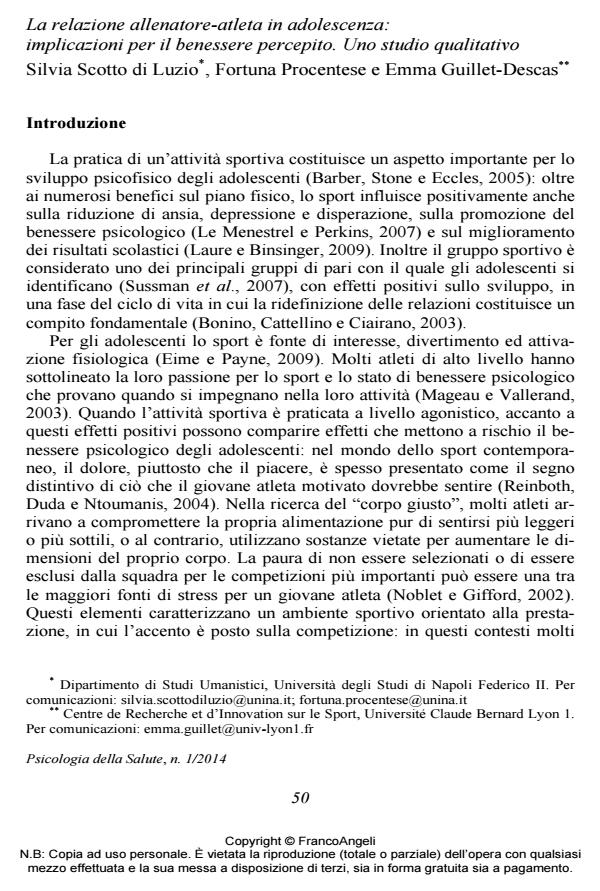La relazione allenatore-atleta in adolescenza: implicazioni per il benessere percepito. Uno studio qualitativo
Titolo Rivista PSICOLOGIA DELLA SALUTE
Autori/Curatori Silvia Scotto di Luzio, Fortuna Procentese, Emma Guillet-Descas
Anno di pubblicazione 2014 Fascicolo 2014/1
Lingua Italiano Numero pagine 23 P. 50-72 Dimensione file 785 KB
DOI 10.3280/PDS2014-001003
Il DOI è il codice a barre della proprietà intellettuale: per saperne di più
clicca qui
Qui sotto puoi vedere in anteprima la prima pagina di questo articolo.
Se questo articolo ti interessa, lo puoi acquistare (e scaricare in formato pdf) seguendo le facili indicazioni per acquistare il download credit. Acquista Download Credits per scaricare questo Articolo in formato PDF

FrancoAngeli è membro della Publishers International Linking Association, Inc (PILA)associazione indipendente e non profit per facilitare (attraverso i servizi tecnologici implementati da CrossRef.org) l’accesso degli studiosi ai contenuti digitali nelle pubblicazioni professionali e scientifiche
I diversi contesti relazionali in cui si svolgono le attività sportive a livello agonistico e, in particolare, il comportamento e lo stile interpersonale dell’allenatore svolgono un ruolo fondamentale nel plasmare i potenziali effetti psicologici, emotivi e fisici (sia positivi che negativi) della partecipazione sportiva in adolescenza. Obiettivo del presente lavoro è stato esplorare il processo di costruzione e di sviluppo della relazione allenatore-atleta e le ripercussioni della qualità di tale relazione sul benessere personale percepito dai protagonisti. A tal fine, sono stati intervistati 50 atleti adolescenti e 21 allenatori, provenienti da società sportive campane. Le interviste, trascritte verbatim, sono state analizzate attraverso l’approccio della Grounded Theory. Dall’analisi sono emerse 13 categorie raggruppate in 3 macro aree concettuali: 1) Ruoli e compiti nella relazione allenatore-atleta. 2) La vittoria: punto di arrivo o punto di partenza? 3) L’evoluzione della relazione in rapporto ai sistemi di riferimento. La core category individuata è Benefici della relazione: dalla solitudine alla condivisione. Dalla lettura del fenomeno emergono due diversi stili interattivi che caratterizzano la relazione allenatore-atleta, che sono fortemente influenzati dal significato simbolico attribuito al concetto di vittoria e influiscono sulla percezione di benessere e di partecipazione. È stata inoltre individuata una dimensione di profonda solitudine, legata alla percezione di una difficoltà nel ritagliare uno spazio e un tempo dedicati alla riflessione e al dialogo rispetto alla natura della relazione stessa. Ciò rimanda alla necessità di teorizzare ed intervenire sulla percezione dei contesti relazionali in un’ottica di prevenzione del drop-out e di promozione del benessere.
Parole chiave:Relazione allenatore-atleta, benessere percepito, sport, adolescenza, Self determination Theory
- Construction and validation of the Sport Sense of Community in Adolescence Questionnaire (SSCAQ) Silvia Scotto di Luzio, Emma Guillet‐Descas, Fortuna Procentese, Guillaume Martinent, in Journal of Community Psychology /2017 pp.783
DOI: 10.1002/jcop.21892 - Protective and risk social dimensions of emergency remote teaching during COVID‐19 pandemic: A multiple mediation study Fortuna Procentese, Flora Gatti, Emiliano Ceglie, in Journal of Community Psychology /2023 pp.67
DOI: 10.1002/jcop.22879 - People‐nearby applications and local communities: Questioning about individuals’ loneliness and social motivations toward people‐nearby applications Fortuna Procentese, Flora Gatti, in Journal of Community Psychology /2019 pp.1282
DOI: 10.1002/jcop.22175
Silvia Scotto di Luzio, Fortuna Procentese, Emma Guillet-Descas, La relazione allenatore-atleta in adolescenza: implicazioni per il benessere percepito. Uno studio qualitativo in "PSICOLOGIA DELLA SALUTE" 1/2014, pp 50-72, DOI: 10.3280/PDS2014-001003